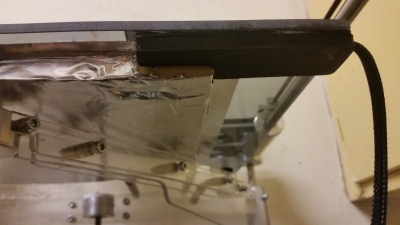You’d think it was winter
I’ve come to realize I need to break out a space heater in my workshop in the winter. My knuckles still ache from the cold. And this is Northern California. No wonder I don’t live in New York or Minnesota.

What happens when you eviscerate a 3D printer.
Having just stripped down the printer (i.e. all wires and electronics are pulled, while the motors, extruders, hot end are still in place), it is high time I start figuring out how to rebuild it. A friendly comment from Arthur Wolf of Smoothieboard got me thinking a lot about their electronics package (seeing as I have an affinity for open source hardware and software), which also got me thinking about not only the stepper drivers that we would need, but the power for the heated bed.
Nichrome, here we come
So, tonight I decided to take a look at the heated bed that is installed on the BFB3000.

What a shocker. It’s not something open source.
What a surprise, it’s proprietary. No Prusa bed heater here, not when those clever chaps at Bits For Bytes can invent the wheel all over again!
Much proprietary. So amaze.
Because I knew this was tied to line voltage when I tore it apart, I decided to check the bed resistance. It measured 27.5Ω, and when you throw a 120VAC load across it, you get a toasty 525W heat source. Not shabby at all, should heat up quick and stay as hot as you can stand, for only a few amps of mains voltage.
PID is for beermaking
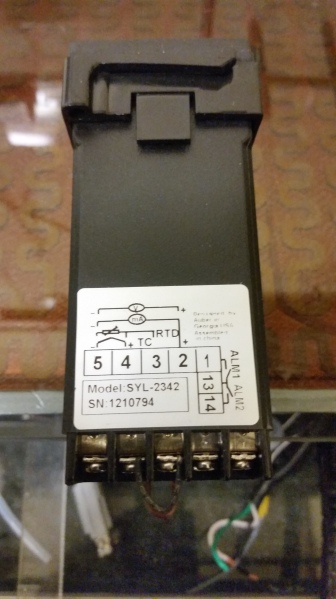
What a cute little PID. Seems we’re using a PT100 thermistor, too.
However, given the PID controller’s mechanical relays (not to mention my previous gripe about it being a separate control loop outside of the printer control itself), the need for the PID to cycle on and off to hold the bed at the setpoint value would wear that relay out with daily use. Sure, most mechanical relays have lifespans at least in the six figures, but I lost track of how much the PID was cycling, since its tuning had it running probably a 5% duty cycle, perhaps less, so as not to overshoot the setpoint.
At any rate, the point here is that the PID controller is out. It will end up being a fermentation temperature control or some other equally appropriate task, as it appears a lot of Auber Instruments devices are used for that.
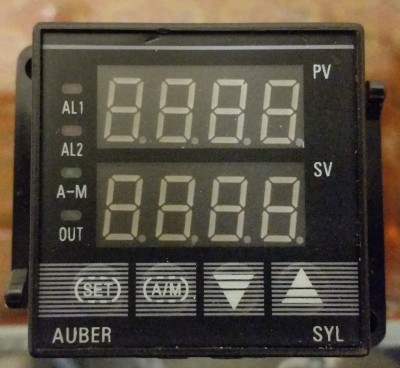
That’s okay, Auber SYL-2342. We’ll get you brewing beer in no time.
A little black box
By all accounts, the heated bed looks to be sealed up tightly enough that I don’t want to inflict catastrophic damage to the heating element just to see if there is a resistor I can replace that would make 24VDC operation feasible. Perhaps I need to accept the 120VAC heated bed, and just resort to a nicely fan-cooled solid-state relay to cycle it, instead of beating some poor mechanical relay to death. The upside would be the load on the control board would be reduced by a fair amount, as it would only be concerned with driving steppers.
But… there’s this little interface box between the wires going to the heated bed, and the actual heating elements. This is where some secret sauce is happening, I just know it.
The itch starts to form in my mind and I can’t let it go.
What’s more, the little interface box is printed. Most likely ABS, given that it’s right next to the heating elements.
Since it’s printed, that implies that if it were to be broken in some ill-advised attempt to pry it off, creating a replacement wouldn’t be impossible. The perpetrator would only have to be concerned with not breaking the glass.
Yes… a mystery…
Housekeeping
As a side note, I’ve come to realize that the extruders and hot ends on this printer are just about as proprietary as it gets. I will go into exhaustive detail on the shameful closed-ness of these elements later, but suffice it to say that I’m interested in replacing them.
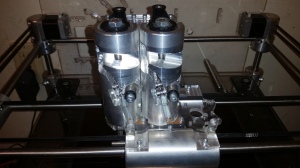
Lovely to look at, but I get the feeling they are not as effective as they could be
Based on a podcast by fellow Chimera members Whitney and Andy, where they talk about the new multiple-extrusion hot ends by E3D, it got me thinking that I should replace the impossible-to-service-and-replace BFB3000 hot end and the machined-from-solid-aluminum extruders with something, well, more open. Not saying that E3D is the OSHW poster child, but at least they’re considered a leader, if not best-in-class for hot end development.
Then I started looking at extruders, and thought that, with the cable support system that ran all the wires and the filament feed tubes, perhaps doing a Bowden-style extruder mounted to the back wall of the printer would be a good idea. With stiff tubing, hysteresis would be lessened, and it would make the hot end sled so much simpler.
I haven’t made up my mind, but this is where my head is going currently.
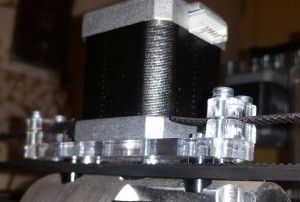
The X stepper carriage is solid, but it’s deflecting the Y belt.
Add to that the sad state of affairs with some of the basic mechanics going on here, and I’ve come to realize that there is a fair bit to do on this little device. I will be printing or laser cutting new carriages for the hot end, and based on how the X motor and Y belt are not getting along with each other, some sort of redesigned piece to move it or offset it just enough to make room for the belt will take place.
Much to do. How many weeks of winter are left? Gotta dig out that space heater…
